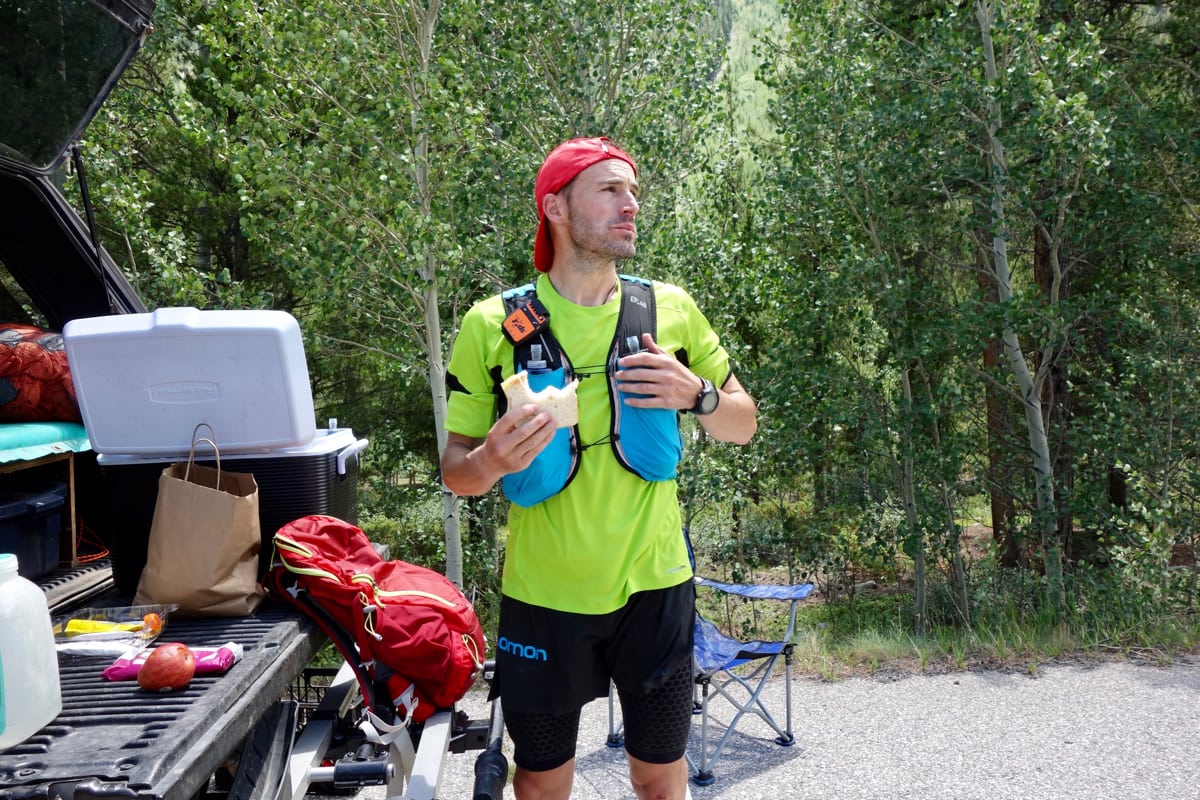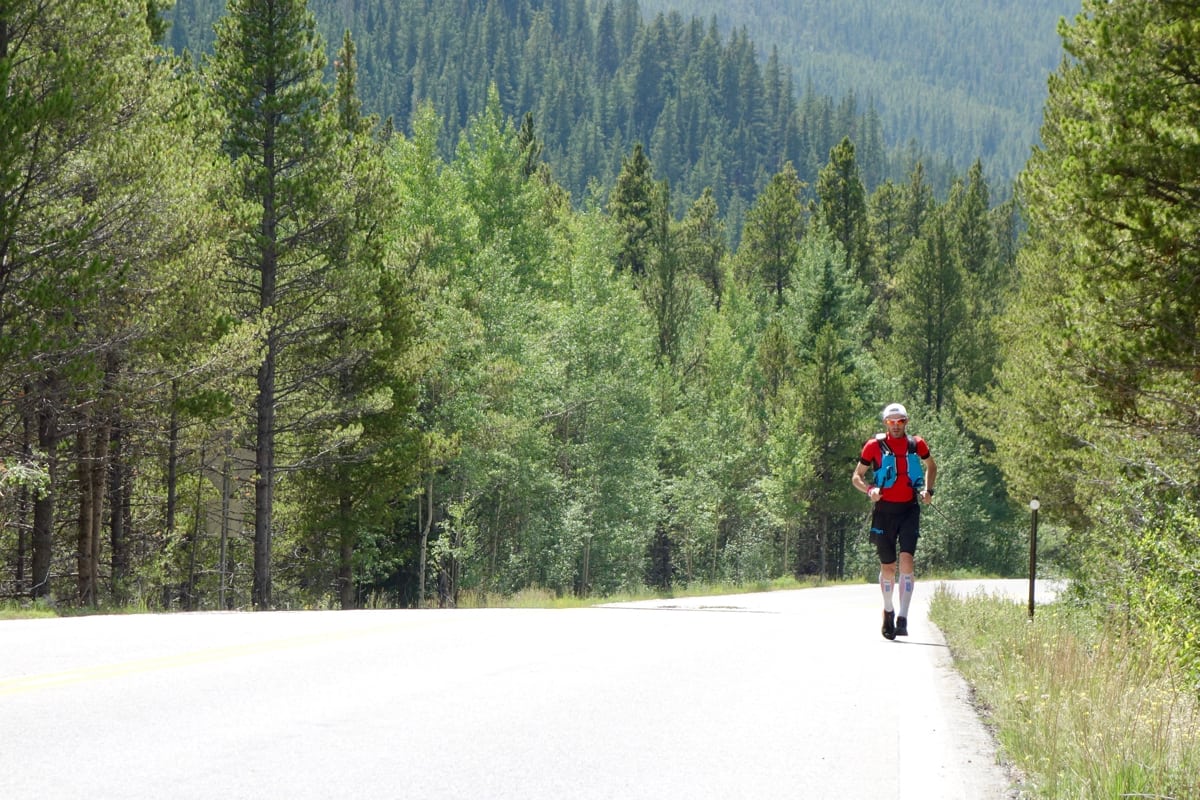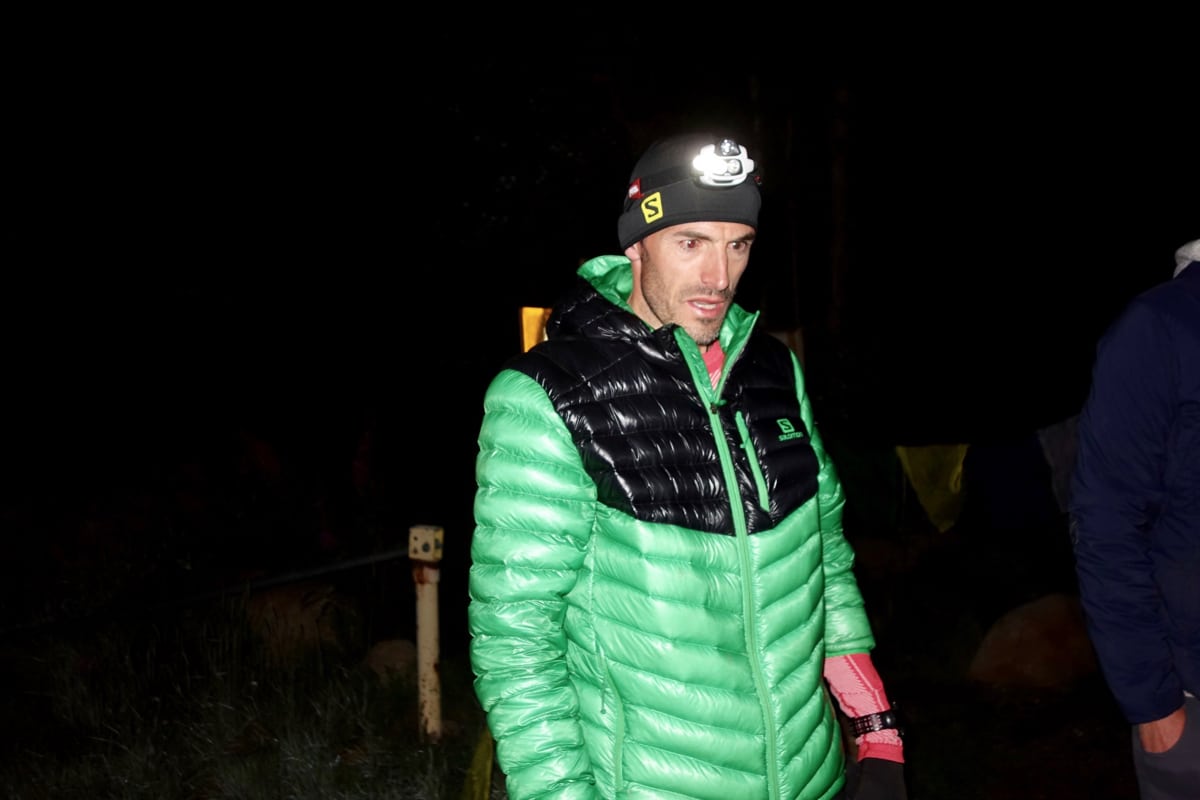On August 1st through 3rd, 2017, Spain’s Iker Karrera set a new fastest known time on the Nolan’s 14 line in the Sawatch Range of Colorado in 47 hours and 40 minutes. In this interview, Iker talks about his month in Colorado, which included taking sixth at the 2017 Hardrock 100, scouting the Nolan’s 14 line while living in Leadville, how his record attempt played out, and what his effort means for the absolute potential of mountain runners on the Nolan’s 14 line.
The Nolan’s 14 line is a link-up of 14 mountains in excess of 14,000 feet in the Sawatch Range. Those challenging the line may connect the summits by whatever means they choose, but routes commonly add up to about 100 miles in length, about 44,000 feet of climbing, and about half off trail. The previous Nolan’s 14 FKT was 53 hours and 39 minutes, and it was set by Andrew Hamilton in 2015. Iker traveled in the south-to-north direction.
The following is a transcript from a phone interview conducted the day after his successful attempt.

Iker Karrera during the first day of his attempt, looking up toward Mount Yale, peak 5. Photo: iRunFar/Meghan Hicks
iRunFar: Congratulations! It’s almost a day later. How are you feeling?
Iker Karrera: Good. Really good. I’m tired as you know, very tired, but I feel good. My muscles are tired, but I have no pain. I can walk normally. Physically, I’m very good. Mentally, at the moment, I have not assimilated all the work that I did these days, not only the two days, but the days before scouting the route. It was also hard days.
iRunFar: A lot of people today are talking about what you’ve done the last couple days on the Nolan’s route following up having just run Hardrock 100 a couple weeks before. A lot of people are considering the physical aspect, but more for you is it the mental?
Karrera: I think physical part is very important, but mentally, you have to be very, very focused and very mentally strong and full of motivation. Otherwise, it’s not possible to do these activities. Nolan’s, as you know, is very hard, so mentally you must be very strong and very focused.
iRunFar: I think you said before your attempt that you had been thinking about Nolan’s for several years. Do you remember how you learned about it and how it became important to you?
Karrera: I remember when Anton Krupicka tried it, and I felt after that, Actually, this is interesting. Maybe someday, why not? I think when Anton tried it, after that, really in my mind, it introduced Nolan’s in this moment.
iRunFar: After Hardrock this year, you came and began staying in Leadville for a few weeks up until your attempt. You scouted almost all of the line. What was it like, putting the vision that you had for Nolan’s in your head, what you’ve been imagining all those years, what was it like seeing it in person?
Karrera: Before I came here, I only had the information that was on the web page. I found that it was a very hard activity. When I was scouting the route, I felt, Oof, this is more hard than the web page said. Now, I think really to be prepared and very, very, very good, it’s good to be here in front of this activity. I have much respect after scouting—I think I wrote something after scouting, I respect a lot all the people who try to do Nolan’s and all the people that have obtained the finish. Just to finish, I think it’s a great victory. After I did it, now, I think it’s an activity that is not… I wanted to understand it well. I think this activity is not for all the people.
iRunFar: Last night when you finished, you expressed—I’m not sure—maybe something like an equal amount of happiness and sadness. Now that it’s a day later, how are you feeling?
Karrera: Something similar, really. I’m happy because I think the activity was well done, but I’m not totally happy because you know sometimes during the activity, the final time is not the real time that I can or could do. For that, I’m not totally happy because I think I’m not from here, so for me to come here once again is not very easy. I know that I had only one opportunity to do Nolan’s, and some circumstances, the final result changed the real positivity.

Iker Karrera refueling at the La Plata Trailhead after completing peak 12, La Plata. Photo: iRunFar/Meghan Hicks
iRunFar: Before your attempt, you publicly said to your social-media followers in Spanish that you’d like to finish it in under two days, 48 hours. You did that, but I think you had written splits that were quite a bit faster, and in your head, you wanted to go a number of hours faster than 48 hours?
Karrera: Yes, to finish under 48 hours was the realistic objective and possible objective, but I know really inside that it was possible to obtain a better result—less hours, less time. I am confident that it’s possible, but 48 hours was a realistic result having concern for all the difficulties.
iRunFar: You had sort of two types of difficulties. I wanted to briefly talk about those. The navigation problems—I think you had three navigation problems, and they were all in the dark?
Karrera: Yes, the first problem was after Tabeguache. I took the wrong way going down to the valley on the wrong side. I hiked Shavano twice. The second one was in Huron, in the valley to hike Huron. I took not the best way. I took one way too far left, and I lost the good time of maybe half hour or maybe more like an hour there. The last was downhill on Massive in the night. Really, before the activity, after I scouted, and when I decided my time to start, I thought I needed to arrive to Mount Massive with daylight because the descent off Mount Massive, you must take a good trail in the forest, and it was complicated for me. I thought, This part, I must arrive with daylight. Finally there, I was totally lost. I was lost many times. Mentally it was a really hard moment because I feel in the moment that this activity was finished. I can’t follow, and I’m tired and can’t eat. Oof, this activity is finished. I can’t arrive to the Fish Hatchery until tomorrow with daylight. It was a very hard moment, but finally the technology helped me. I saw, Ahh, I have my mobile phone with me, so I’m going to check if my mobile GPS can help me. Yes, GPS on mobile phone helped me to arrive to Fish Hatchery.
iRunFar: Another one of the challenges you had was that your crew missed seeing you twice in the second half of your effort, and that required you to go over Huron Peak and La Plata with very little to no food. Can you talk about what that was like?
Karrera: Yes. First of all, I want to say that my crew was wonderful. They worked very good. They were from Leadville Outdoors. They worked a lot and good. Sometimes things happen and at two points, they couldn’t arrive there when I have passed. The first point was Clohesy Lake, but this point was not the most important. On Huron, I did Huron with not enough food, but I think before I had been eating good, so Huron with less food I can do. But when I arrived to Winfield and I didn’t find Heather, it was a very bad moment—a very, very bad moment. Two runners that I saw before told me, “Your friends are waiting at La Plata.” I said, “Oh, okay, thank you.” When I arrived to Winfield, I didn’t see Heather, and I thought, Oh, maybe she has thought it’s better to go to the point where you start hiking to La Plata. So, I’m going there. So, I go there to La Plata trailhead, and Heather was not there. Oh, my goodness. I have nothing to eat. Maybe I have made a mistake and it’s better to go back to Winfield, and maybe Heather is there. So, I decided to run back to Winfield, and in Winfield, Heather was not there. Oh, this is the end. I have nothing to eat. What can I do? I saw one man in one of the cabins in Winfield. I say, “I’m sorry, do you have something to eat?” This man was the best volunteer. He gave me two peaches and one piece of bread. I follow my activity with this food until La Plata trailhead for the other side. These are the other circumstances that I think affected me mentally and physically.
iRunFar: You spent two days in one of Colorado’s most well-known and most aesthetic mountain ranges. You saw two sunsets; you summited 14 mountains, one of them twice. Can you talk about some of the highs—the places where you were mentally or physically very high and enjoying yourself?
Karrera: There were many, many feelings that I have about Colorado mountains. They are great mountains, spectacular mountains. I think maybe Leadville area could be, after Chamonix[,France], one of the best places to practice trail running. I think the area of Hardrock has maybe more facilities for winter to practice trail running, but I think the Leadville area for trail running is one of the best places in the world really. It’s spectacular. You have a variety of trails—technical trails, high altitude, in the forest you can run fast and enjoy. I think I discovered one of the best places in the world to practice trail running.
iRunFar: I think there will be a lot of people in Colorado who will agree with you. When you go home to Spain, people won’t have much familiarity with Nolan’s beyond the little bits and pieces that you have been giving them and that you’ll continue to share with them. When somebody walks up to you and says, “Wow, congratulations! What is Nolan’s?” What will you say to them?
Karrera: It’s not simple to explain all that is Nolan’s. How to explain? It’s difficult, really. It’s difficult. I think if I tell them that it’s one of the hardest activities that is possible to do in all the world, but at the same time it’s one of the most spectacular activities. I think it’s not so far for what is Nolan’s. I think it’s a good form to explain to them what is Nolan’s.
iRunFar: My last question for you, you ran under 48 hours. Finishing Nolan’s in 48 hours is like setting a new standard for the route. You reset the record by six hours. I think there are a few people out there who thought maybe they can run something like 48 to 50 hours, but nobody had done it. Do you have any thoughts on resetting the standard on Nolan’s by so much?
Karrera: Really, I think 48 hours is possible for more runners. Good runners can even do near 48 hours really I think because it’s possible to do it in less than 48 hours. Forty-eight hours I think is possible for some front runners around the world. I think psychologically, it’s less than two days. Psychologically, it’s another level or something like that that can be under two days. Really, I think it’s possible that many more people can do it in less than 48 hours and more less. After my activity, I think that the objective that Anton Krupicka had at 30 hours, I think it’s not possible, but I think there are some runners, or one runner, that can do it in less than 40 hours. You know who it is, this runner. I think Kilian [Jornet] can do it in less than 40 hours.
iRunFar: A few people have tossed around the idea that there might be one or two or three men who might be able to do less than 40 hours on that line. I think what you’ve done is a stepping stone, showing us that we’re not even close to our potential there. I think what you’ve done has shown us that we humans have so much more potential on something like Nolan’s.
Karrera: Yes, I think my activity shows human potential physically and mentally. For trail runners, I think my activity shows that it’s possible to do this kind of activity, and it’s possible to do Nolan’s between 40 and 45 hours.
iRunFar: Spectacular, Iker, congratulations! It was really fun to get to see a little bit of your experience. Massive congratulations!
Karrera: Thank you, Meghan.


